weight Citroen NEMO 2011 1.G Owner's Manual
[x] Cancel search | Manufacturer: CITROEN, Model Year: 2011, Model line: NEMO, Model: Citroen NEMO 2011 1.GPages: 180, PDF Size: 9.06 MB
Page 4 of 180
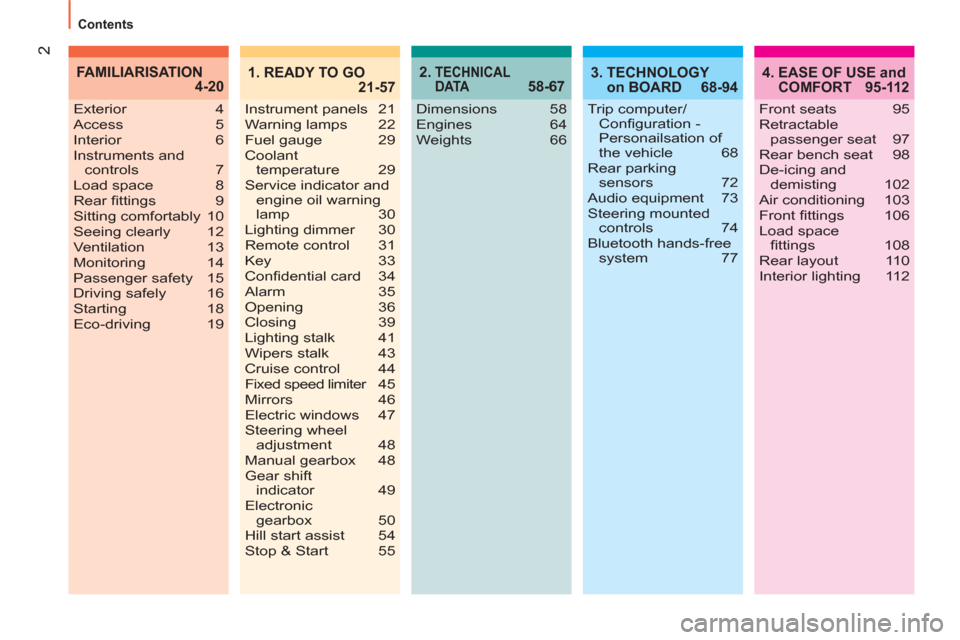
2
Contents
2. TECHNICAL
D ATA 58-674. EASE OF USE and
COMFORT 95-112
Dimensions 58
Engines 64
Weights 66 Exterior 4
Access 5
Interior 6
Instruments and
controls 7
Load space 8
Rear fi ttings 9
Sitting comfortably 10
Seeing clearly 12
Ventilation 13
Monitoring 14
Passenger safety 15
Driving safely 16
Starting 18
Eco-driving 19
FAMILIARISATION
4-20
Front seats 95
Retractable
passenger seat 97
Rear bench seat 98
De-icing and
demisting 102
Air conditioning 103
Front fi ttings 106
Load space
fi ttings 108
Rear layout 110
Interior lighting 112
3. TECHNOLOGY
on BOARD 68-94
Trip computer/
Confi guration -
Personailsation of
the vehicle 68
Rear parking
sensors 72
Audio equipment 73
Steering mounted
controls 74
Bluetooth hands-free
system 77
1. READY TO GO
21-57
Instrument panels 21
Warning lamps 22
Fuel gauge 29
Coolant
temperature 29
Service indicator and
engine oil warning
lamp 30
Lighting dimmer 30
Remote control 31
Key 33
Confi dential card 34
Alarm 35
Opening 36
Closing 39
Lighting stalk 41
Wipers stalk 43
Cruise control 44
Fixed speed limiter 45
Mirrors 46
Electric windows 47
Steering wheel
adjustment 48
Manual gearbox 48
Gear shift
indicator 49
Electronic
gearbox 50
Hill start assist 54
Stop & Start 55
Page 68 of 180

66
Weights
WEIGHTS
Consult your registration certifi cate.
The legislation on towed loads in force in each country must be observed. For information regarding your vehicle's towing possibilities and its
gross train weight, consult a CITROËN dealer or a qualifi ed workshop.
Page 126 of 180
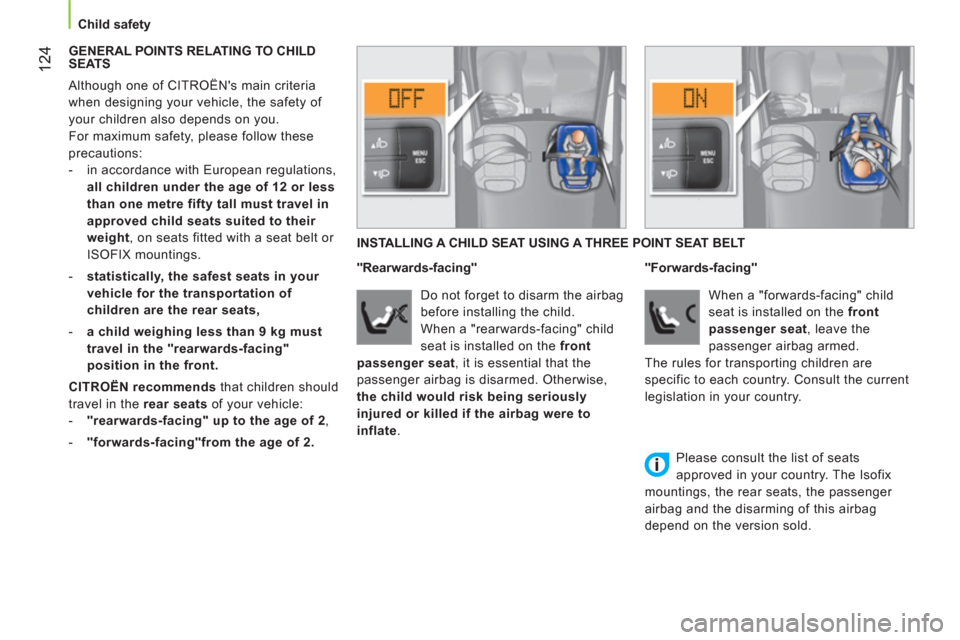
124
Child safety
GENERAL POINTS RELATING TO CHILD
SEATS
Although one of CITROËN's main criteria
when designing your vehicle, the safety of
your children also depends on you.
For maximum safety, please follow these
precautions:
- in accordance with European regulations,
all children under the age of 12 or less
than one metre fifty tall must travel in
approved child seats suited to their
weight , on seats fitted with a seat belt or
ISOFIX mountings.
- statistically, the safest seats in your
vehicle for the transportation of
children are the rear seats,
- a child weighing less than 9 kg must
travel in the "rearwards-facing"
position in the front.
CITROËN recommends that children should
travel in the rear seats of your vehicle:
- "rearwards-facing" up to the age of 2 ,
- "forwards-facing"from the age of 2.
INSTALLING A CHILD SEAT USING A THREE POINT SEAT BELT
"Rearwards-facing"
Do not forget to disarm the airbag
before installing the child.
When a "rearwards-facing" child
seat is installed on the front
passenger seat , it is essential that the
passenger airbag is disarmed. Otherwise,
the child would risk being seriously
injured or killed if the airbag were to
inflate .
"Forwards-facing"
When a "forwards-facing" child
seat is installed on the front
passenger seat , leave the
passenger airbag armed.
The rules for transporting children are
specific to each country. Consult the current
legislation in your country.
Please consult the list of seats
approved in your country. The Isofix
mountings, the rear seats, the passenger
airbag and the disarming of this airbag
depend on the version sold.
Page 128 of 180
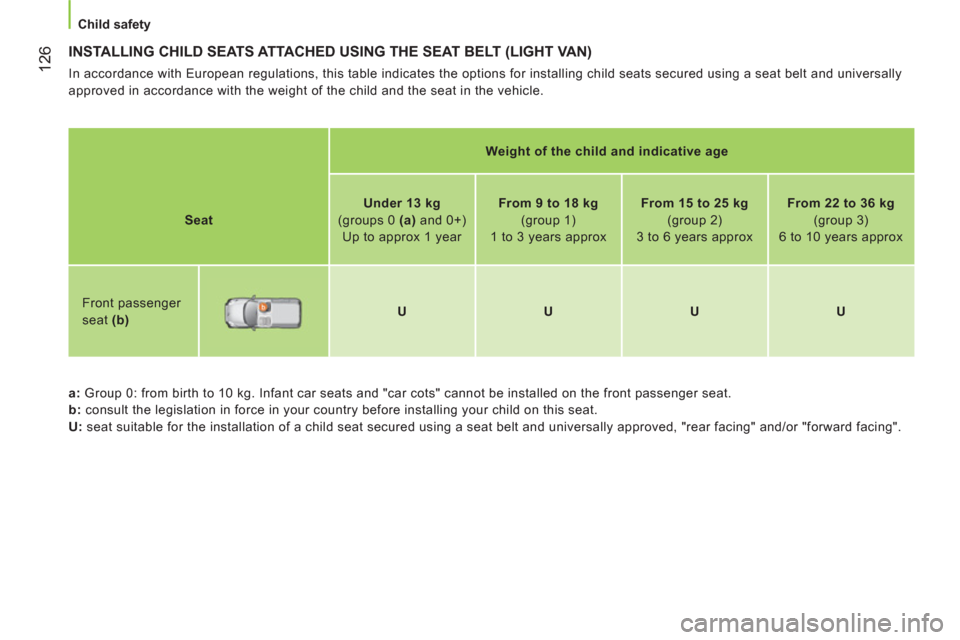
126
Child safety
INSTALLING CHILD SEATS ATTACHED USING THE SEAT BELT (LIGHT VAN)
In accordance with European regulations, this table indicates the options for installing child seats secured using a seat belt and universally
approved in accordance with the weight of the child and the seat in the vehicle.
Weight of the child and indicative age
Seat
Under 13 kg
(groups 0 ( a ) and 0+)
Up to approx 1 year
From 9 to 18 kg
(group 1)
1 to 3 years approx
From 15 to 25 kg
(group 2)
3 to 6 years approx
From 22 to 36 kg
(group 3)
6 to 10 years approx
Front passenger
seat ( b )
U
U
U
U
a
: Group 0: from birth to 10 kg. Infant car seats and "car cots" cannot be installed on the front passenger seat.
b
: consult the legislation in force in your country before installing your child on this seat.
U
: seat suitable for the installation of a child seat secured using a seat belt and universally approved, "rear facing" and/or "forward facing".
Page 129 of 180
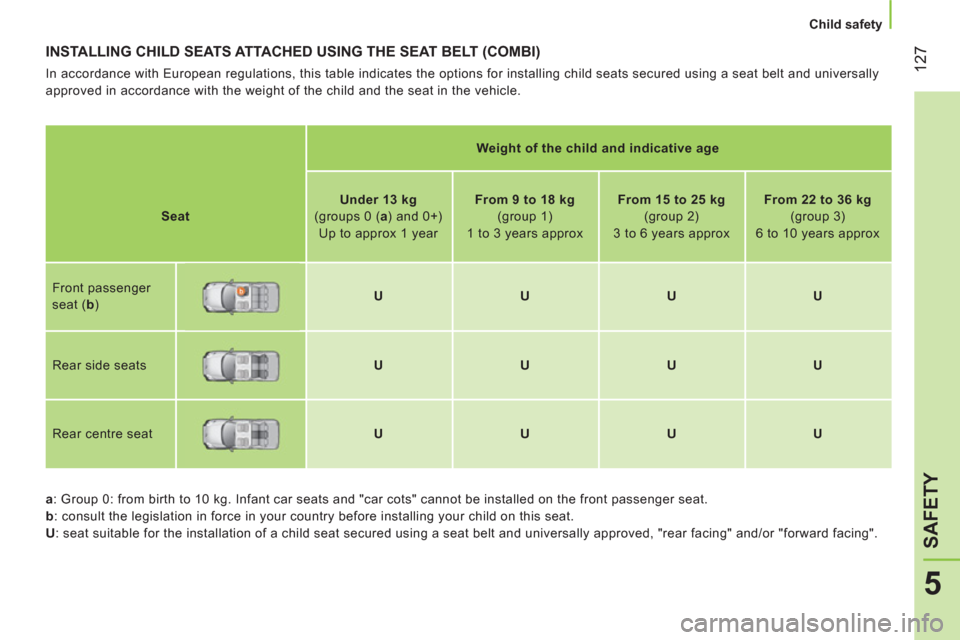
127
5
SAFETY
Child safety
INSTALLING CHILD SEATS ATTACHED USING THE SEAT BELT (COMBI)
In accordance with European regulations, this table indicates the options for installing child seats secured using a seat belt and universally
approved in accordance with the weight of the child and the seat in the vehicle.
Weight of the child and indicative age
Seat
Under 13 kg
(groups 0 ( a
) and 0+)
Up to approx 1 year
From 9 to 18 kg
(group 1)
1 to 3 years approx
From 15 to 25 kg
(group 2)
3 to 6 years approx
From 22 to 36 kg
(group 3)
6 to 10 years approx
Front passenger
seat ( b
)
U
U
U
U
Rear side seats
U
U
U
U
Rear centre seat
U
U
U
U
a
: Group 0: from birth to 10 kg. Infant car seats and "car cots" cannot be installed on the front passenger seat.
b
: consult the legislation in force in your country before installing your child on this seat.
U
: seat suitable for the installation of a child seat secured using a seat belt and universally approved, "rear facing" and/or "forward facing".
Page 132 of 180
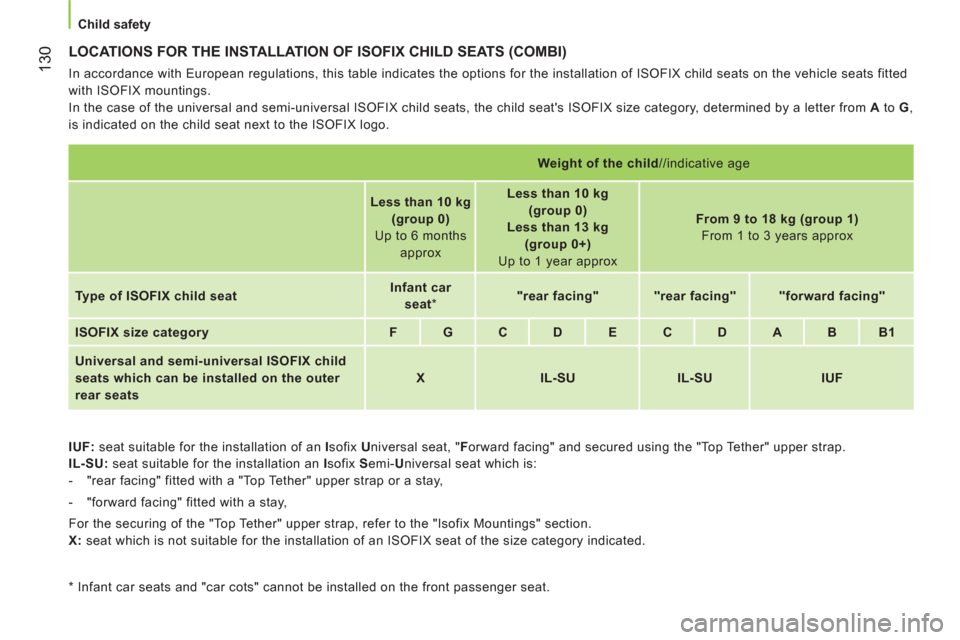
130
Child safety
LOCATIONS FOR THE INSTALLATION OF ISOFIX CHILD SEATS (COMBI)
In accordance with European regulations, this table indicates the options for the installation of ISOFIX child seats on the vehicle seats fitted
with ISOFIX mountings.
In the case of the universal and semi-universal ISOFIX child seats, the child seat's ISOFIX size category, determined by a letter from A
to G
,
is indicated on the child seat next to the ISOFIX logo.
IUF:
seat suitable for the installation of an I
sofix U
niversal seat, " F
orward facing" and secured using the "Top Tether" upper strap.
IL-SU:
seat suitable for the installation an I
sofix S
emi- U
niversal seat which is:
- "rear facing" fitted with a "Top Tether" upper strap or a stay,
- "forward facing" fitted with a stay,
For the securing of the "Top Tether" upper strap, refer to the "Isofix Mountings" section.
X:
seat which is not suitable for the installation of an ISOFIX seat of the size category indicated.
Weight of the child/ /indicative age
Less than 10 kg
(group 0)
Up to 6 months
approx
Less than 10 kg
(group 0)
Less than 13 kg
(group 0+)
Up to 1 year approx
From 9 to 18 kg (group 1)
From 1 to 3 years approx
Type of ISOFIX child seat
Infant car
seat
*
"rear facing"
"rear facing"
"forward facing"
ISOFIX size category
F
G
C
D
E
C
D
A
B
B1
Universal and semi-universal ISOFIX child
seats which can be installed on the outer
rear seats
X
IL-SU
IL-SU
IUF
*
Infant car seats and "car cots" cannot be installed on the front passenger seat.
Page 134 of 180
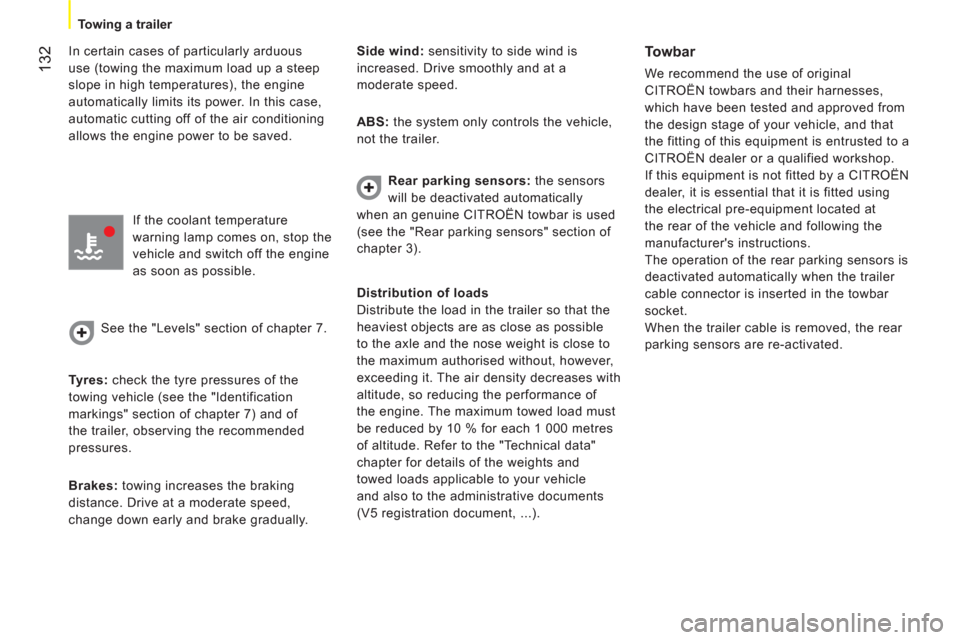
132
Towing a trailer
In certain cases of particularly arduous
use (towing the maximum load up a steep
slope in high temperatures), the engine
automatically limits its power. In this case,
automatic cutting off of the air conditioning
allows the engine power to be saved.
If the coolant temperature
warning lamp comes on, stop the
vehicle and switch off the engine
as soon as possible.
See the "Levels" section of chapter 7.
Tyres:
check the tyre pressures of the
towing vehicle (see the "Identification
markings" section of chapter 7) and of
the trailer, observing the recommended
pressures.
Brakes:
towing increases the braking
distance. Drive at a moderate speed,
change down early and brake gradually.
Side wind:
sensitivity to side wind is
increased. Drive smoothly and at a
moderate speed.
ABS:
the system only controls the vehicle,
not the trailer.
Rear parking sensors:
the sensors
will be deactivated automatically
when an genuine CITROËN towbar is used
(see the "Rear parking sensors" section of
chapter 3).
Towbar
We recommend the use of original
CITROËN towbars and their harnesses,
which have been tested and approved from
the design stage of your vehicle, and that
the fitting of this equipment is entrusted to a
CITROËN dealer or a qualified workshop.
If this equipment is not fitted by a CITROËN
dealer, it is essential that it is fitted using
the electrical pre-equipment located at
the rear of the vehicle and following the
manufacturer's instructions.
The operation of the rear parking sensors is
deactivated automatically when the trailer
cable connector is inserted in the towbar
socket.
When the trailer cable is removed, the rear
parking sensors are re-activated.
Distribution of loads
Distribute the load in the trailer so that the
heaviest objects are as close as possible
to the axle and the nose weight is close to
the maximum authorised without, however,
exceeding it. The air density decreases with
altitude, so reducing the performance of
the engine. The maximum towed load must
be reduced by 10 % for each 1 000 metres
of altitude. Refer to the "Technical data"
chapter for details of the weights and
towed loads applicable to your vehicle
and also to the administrative documents
(V5 registration document, ...).
Page 135 of 180
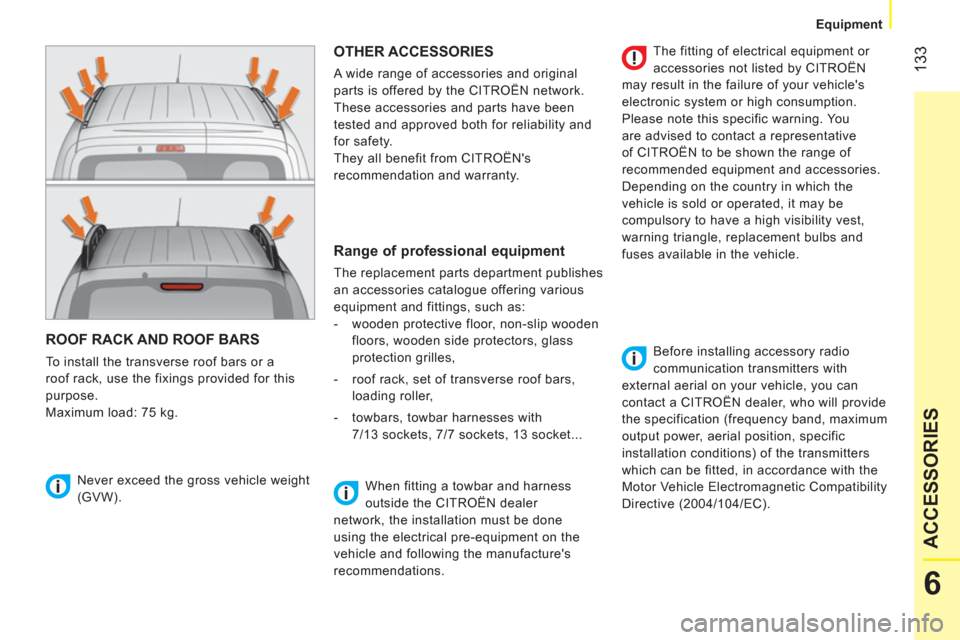
133
6
ACCESSORIES
Equipment
ROOF RACK AND ROOF BARS
To install the transverse roof bars or a
roof rack, use the fixings provided for this
purpose.
Maximum load: 75 kg.
OTHER ACCESSORIES
A wide range of accessories and original
parts is offered by the CITROËN network.
These accessories and parts have been
tested and approved both for reliability and
for safety.
They all benefit from CITROËN's
recommendation and warranty.
Never exceed the gross vehicle weight
(GVW).
Range of professional equipment
The replacement parts department publishes
an accessories catalogue offering various
equipment and fittings, such as:
- wooden protective floor, non-slip wooden
floors, wooden side protectors, glass
protection grilles,
- roof rack, set of transverse roof bars,
loading roller,
- towbars, towbar harnesses with
7/13 sockets, 7/7 sockets, 13 socket...
The fitting of electrical equipment or
accessories not listed by CITROËN
may result in the failure of your vehicle's
electronic system or high consumption.
Please note this specific warning. You
are advised to contact a representative
of CITROËN to be shown the range of
recommended equipment and accessories.
Depending on the country in which the
vehicle is sold or operated, it may be
compulsory to have a high visibility vest,
warning triangle, replacement bulbs and
fuses available in the vehicle.
Before installing accessory radio
communication transmitters with
external aerial on your vehicle, you can
contact a CITROËN dealer, who will provide
the specification (frequency band, maximum
output power, aerial position, specific
installation conditions) of the transmitters
which can be fitted, in accordance with the
Motor Vehicle Electromagnetic Compatibility
Directive (2004/104/EC). When fitting a towbar and harness
outside the CITROËN dealer
network, the installation must be done
using the electrical pre-equipment on the
vehicle and following the manufacture's
recommendations.
Page 156 of 180
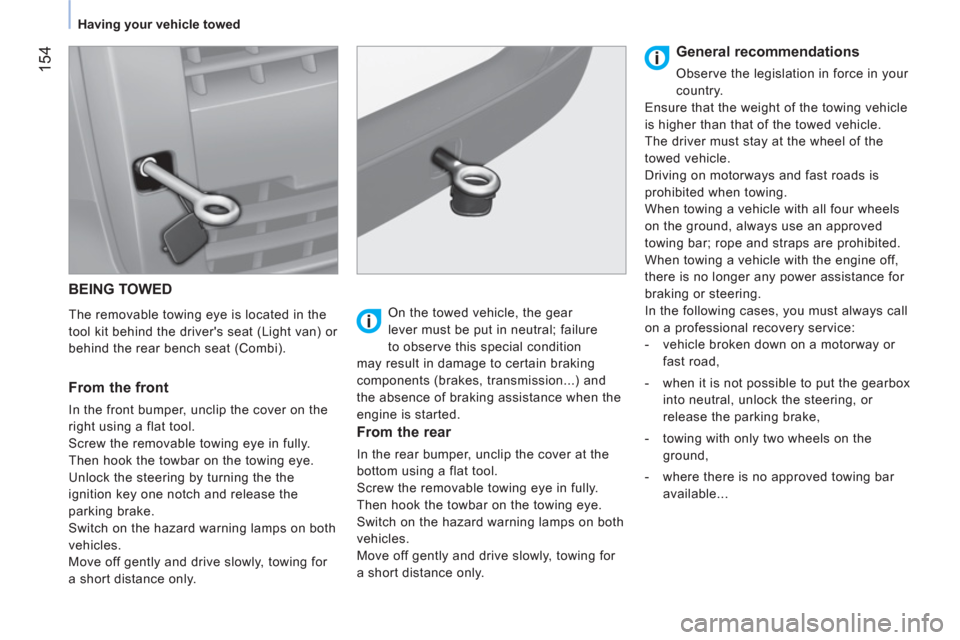
154
Having your vehicle towed
BEING TOWED
The removable towing eye is located in the
tool kit behind the driver's seat (Light van) or
behind the rear bench seat (Combi).
From the front
In the front bumper, unclip the cover on the
right using a flat tool.
Screw the removable towing eye in fully.
Then hook the towbar on the towing eye.
Unlock the steering by turning the the
ignition key one notch and release the
parking brake.
Switch on the hazard warning lamps on both
vehicles.
Move off gently and drive slowly, towing for
a short distance only.
On the towed vehicle, the gear
lever must be put in neutral; failure
to observe this special condition
may result in damage to certain braking
components (brakes, transmission...) and
the absence of braking assistance when the
engine is started.
From the rear
In the rear bumper, unclip the cover at the
bottom using a flat tool.
Screw the removable towing eye in fully.
Then hook the towbar on the towing eye.
Switch on the hazard warning lamps on both
vehicles.
Move off gently and drive slowly, towing for
a short distance only.
General recommendations
Observe the legislation in force in your
country.
Ensure that the weight of the towing vehicle
is higher than that of the towed vehicle.
The driver must stay at the wheel of the
towed vehicle.
Driving on motorways and fast roads is
prohibited when towing.
When towing a vehicle with all four wheels
on the ground, always use an approved
towing bar; rope and straps are prohibited.
When towing a vehicle with the engine off,
there is no longer any power assistance for
braking or steering.
In the following cases, you must always call
on a professional recovery service:
- vehicle broken down on a motorway or
fast road,
- when it is not possible to put the gearbox
into neutral, unlock the steering, or
release the parking brake,
- towing with only two wheels on the
ground,
- where there is no approved towing bar
available...
Page 157 of 180

155
7
QUICK HELP
Identifi cation markings
IDENTIFICATION FEATURES
A. Manufacturer's plate
1. VF Type serial number.
2. Gross vehicle weight (GVW).
3. Gross train weight (GTW).
4. Maximum weight on front axle.
5. Maximum weight on rear axle.
B. Serial number on the body
C. Paint reference
D. Serial number on the fascia
E. Tyre pressures